Neem Baba NCERT Solutions | English for Class 6 PDF Download
Let us do these activities before we read (Page 75)
Q1: A tree is useful to us in many ways. Mention some of these uses. Write them in the picture given below.
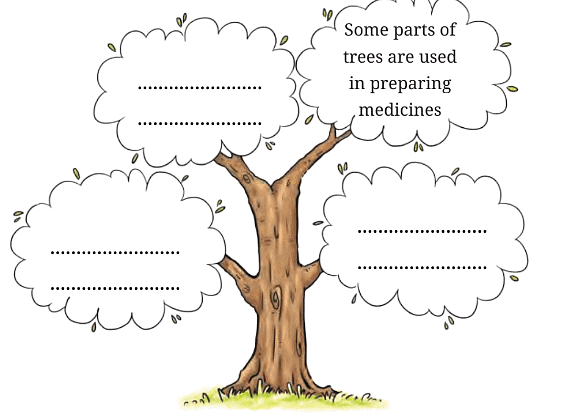
Ans:
Q2: Neem is a common tree in our country. Discuss in groups of four and fill Columns A and B with what you know about the neem tree and what you want to know.

Ans:
Let us discuss (Page 77)
Amber found many facts about the neem tree from Neem Baba. Fill up the fact sheet based on what Neem Baba told her.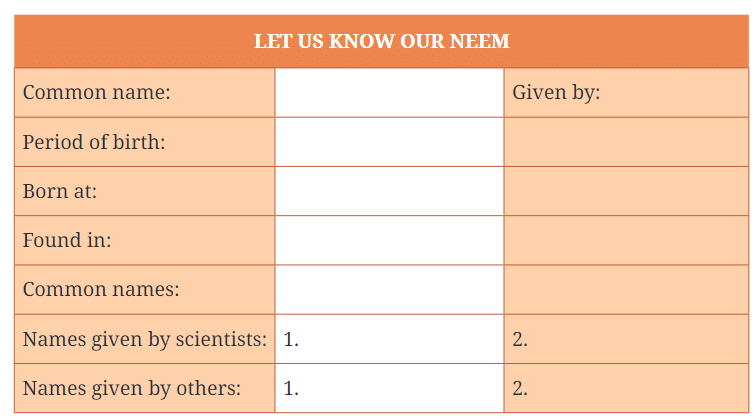
Ans:

Let us discuss (Page 80)
Q1: How is neem useful to farmers?
Ans: Neem is useful to farmers because neem seed powder, when mixed with water and sprayed on plants, prevents locusts from eating the crops. It also helps stop mosquito breeding in rice fields and protects crops from termites and other insects.
Q2: Mention some of the uses of the neem tree.
Ans: Neem tree uses include:
- Making medicines from neem leaves, bark, flowers, fruits, and roots.
- Using neem twigs to clean teeth.
- Using neem leaves to protect clothes from insects.
- Using neem oil in soaps and toothpaste.
- Neem wood is used for furniture as it is termite-resistant.
- Purifying air.
Let us think and reflect (Page 81)
Q1: You just read about the Neem tree. Write any two facts that surprised you the most.
Ans:
- Neem leaves can be used to treat measles and prevent itching.
- Neem seed powder helps increase crop yield by protecting against insects.
Q2: Complete the following sentences.
(a) Amber played in the shade of ______________________.
Ans: Neem Tree
(b) Neem seed powder protects crops from ______________.
Ans: termites, mosquitoes, locusts and other insects.
(c) ______________ is a cost-effective method to stop mosquitoes from breeding in stagnant water.
Ans: Mixing neem seed powder in water.
(d) One reason why doctors advise us to use neem leaves for someone suffering from measles is ______________.
Ans: Because neem leaves have chemical properties that destroy germs and provide comfort from itching.
Q3: Why can Neem Baba not remember the year when he was born?
Ans: Neem Baba cannot remember the year he was born because he is very old and was born millions of years ago.
Q4: Which parts of the neem tree are used to make medicines?
Ans: The parts of the neem tree used to make medicines include leaves, bark, flowers, fruits, and roots.
Let us learn (Page 81,82,83)
Q1: Study these words from the text.
- something
- neem oil
- cleanliness-parting
- well known
- grandmother
- seed powder
- childhood
- well trained
- thought-provoking
Put the compound words given above in their trees. These words are known as compound words. There are three types of compound words, based on how the words are separated.
- Open compound words: spaces between the words.
- Closed compound words: no spaces between the words.
- Hyphenated compound words: hyphens between the words.
You may add some more words: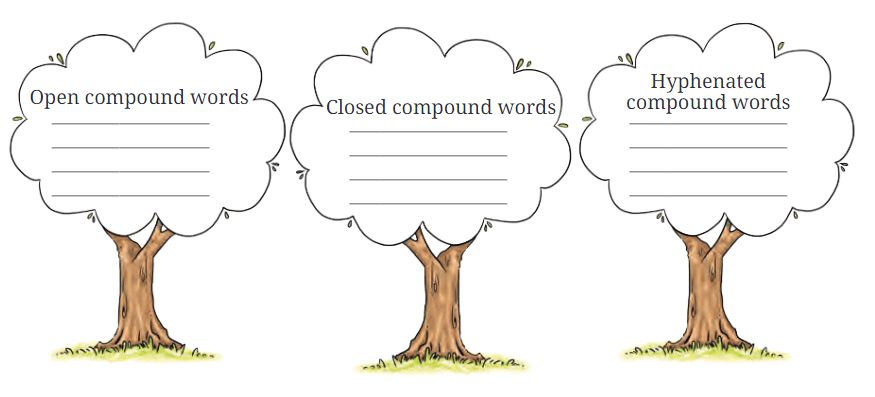 Ans:
Ans:

Q2: Words that tell us what a person is doing are called verbs. In the table given below, match the verbs in the first column showing action in the present to verbs in the second column showing action in the past. Make a sentence with any one form of the verb. One has been done for you.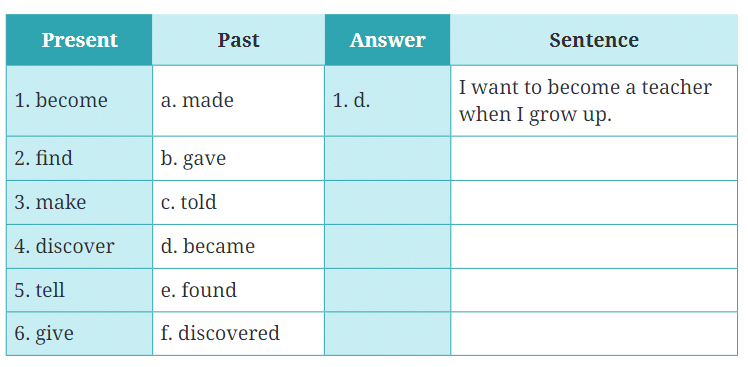
Ans:
Q3: Neem Baba speaks to Amber as if he is a person. This figure of speech is called personification. Let us look at some more examples.
- The leaves whispered in the wind.
- The flowers danced merrily in the breeze.
Ans: Personification is a literary device where human characteristics are attributed to non-human entities. It helps create vivid imagery and emotional connections in writing. Let’s look at the examples provided:
The leaves whispered in the wind.
Here, the leaves are given the human action of whispering, which creates an image of gentle movement and a soft, rustling sound as the wind passes through them.
The flowers danced merrily in the breeze.
In this example, the flowers are described as dancing, which conveys the idea of them swaying joyfully with the gentle breeze, adding a sense of liveliness and cheerfulness to the scene.
Discussion: Personification can make descriptions more engaging and relatable by giving life to inanimate objects or abstract concepts. It allows readers to visualise scenes more vividly and feel a stronger emotional connection to the elements of the story. When Neem Baba speaks to Amber as if he were a person, it not only makes the interaction more engaging but also imbues the neem tree with wisdom and personality, making the information shared more memorable and impactful. Personification is a powerful tool in storytelling and poetry, helping to create rich, imaginative experiences for readers.
Let us listen (Page 83)
Peepal Baba
Rahul: Maa, have you heard about Peepal Baba? Our teacher told us about him today.
Mother: I have not heard about him. Who is he and what does he do?
Rahul: He plants trees along with his team. He also started a movement to plant and save trees.
Mother: That’s wonderful. Where did he get this idea from?
Rahul: When he was studying in a school in Pune, his English teacher gave him the idea to plant trees. He was just 11 years old.
Mother: How did he plant so many trees all over the country as a child?
Rahul: He was born to an army officer’s family in Chandigarh, and whenever they were moved to a new city, he planted more trees.
Mother: But how did he come to be known as Peepal Baba?
Rahul: He used to plant Peepal and Neem trees as they have many uses for us, and told others to do so. So, in the beginning, people made fun of him by calling him Peepal Baba, but he was not bothered and continued to do his work. Now, everyone calls him by that name lovingly.
Mother: He is doing great work. We should learn from him and plant more trees.
Rahul: Yes, Maa. We must tell others to do the same.
Q: You will now listen to a boy speaking to his mother. As you listen, select the correct statements. (refer to page 101 for transcript)
(a) The mother was surprised to know that Peepal Baba had planted trees all over the country.
(b) The mother disliked the work being done by Peepal Baba.
(c) The mother wanted to know more about Peepal Baba.
(d) The boy decided to take care of the trees by listening to Peepal Baba’s journey.
(e) The boy was worried about what his teacher had told him.
Ans: The following statements are the correct statements:
(a) The mother was surprised to know that Peepal Baba had planted trees all over the country.
(c) The mother wanted to know more about Peepal Baba.
(d) The boy decided to take care of the trees by listening to Peepal Baba’s journey.
These statements reflect the positive and curious attitude of both the mother and the boy towards Peepal Baba’s work and their interest in learning more about it.
Let us speak (Page 83)
Collect dry leaves of four different trees and plants around you. Q1: Make one card as given below. On the top, draw the shape of the leaf look at the dry leaf, and colour it. Inside the card, write the name of the tree/plant the leaf is taken from and one of its uses.
Q1: Make one card as given below. On the top, draw the shape of the leaf look at the dry leaf, and colour it. Inside the card, write the name of the tree/plant the leaf is taken from and one of its uses.
Ans: 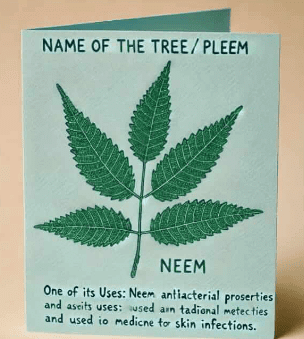
Q2: Now, speak about the whole process of making the card in front of the class.
Ans: Hello Everyone,
Today, I’m going to share with you the process of making a beautiful and informative card about a tree or plant leaf. I chose the neem tree for my example. Here’s how I did it:
Step 1: Collecting the Leaf
First, I collected a dry leaf from the neem tree. It’s important to ensure the leaf is clean and dry before using it for our project.
Step 2: Drawing the Leaf
Next, I took a blank card and drew the shape of the neem leaf on the front. I paid close attention to its details, like the serrated edges and the veins. After outlining, I colored it to make it look as realistic as possible.
Step 3: Writing the Information
Inside the card, I wrote some important information about the neem tree. I included:
Name of the tree/plant: Neem
One of its uses: Neem leaves have antibacterial properties and are used in traditional medicine to treat skin infections.
Step 4: Final Touches
Finally, I reviewed the card to make sure everything was neat and legible. I added any additional details to enhance the presentation.
Conclusion
This project not only helped me learn more about the neem tree but also gave me the chance to practice my drawing and writing skills. It’s a fun and educational activity that I recommend to all of you. Thank you for listening!
Q3: Ask your classmates to identify the leaf and tell them one of its uses. After they answer, open the card, and share what you have written.
Ans: It is a classroom activity, so do it in your class under your teacher’s guidance.
Let us write (Page 84)
Q: You have read about Neem Baba and learnt many things about the neem tree. Look at the trees in your neighbourhood and write a paragraph about any one tree that you like.
- Where it is (roadside/park, etc.)
- How it looks (height, tree trunk, leaves, flowers, etc.)
- Why do you like it (shade, medicinal properties, shelter, beauty, etc)
- Give a title to your paragraph.
Ans: I like Banyan Tree.
The banyan tree near my house is truly majestic. It stands tall on the roadside, with its thick trunk and wide-spreading branches that provide ample shade. The aerial roots hanging from its branches give it a unique and ancient look. The leaves are large, green, and provide a home to many birds and squirrels. I like the banyan tree because of its beauty and the cool shade it offers during hot days. It also has medicinal properties and is known for its longevity.
Let us explore (Page 84)
When people from Persia came to India and saw that a common tree of their country was freely growing here, they started calling the tree Azad Darakhte Hindi. So, the scientific name of Neem in Latin became Azadirachta indica.
Neem has different names in the Indian languages. Discuss with your teacher and find out which Indian languages these names belong to. Ans:
Ans:
|
63 videos|708 docs|70 tests
|
FAQs on Neem Baba NCERT Solutions - English for Class 6
| 1. Who is Neem Baba and what is his significance in the story? |  |
| 2. How does Neem Baba teach the protagonist about the interconnectedness of all living beings? |  |
| 3. What lesson does the protagonist learn from Neem Baba about the importance of respecting nature? |  |
| 4. How does the story of Neem Baba reflect the traditional wisdom of indigenous cultures? |  |
| 5. How does Neem Baba inspire the protagonist to make positive changes in his life and community? |  |

















